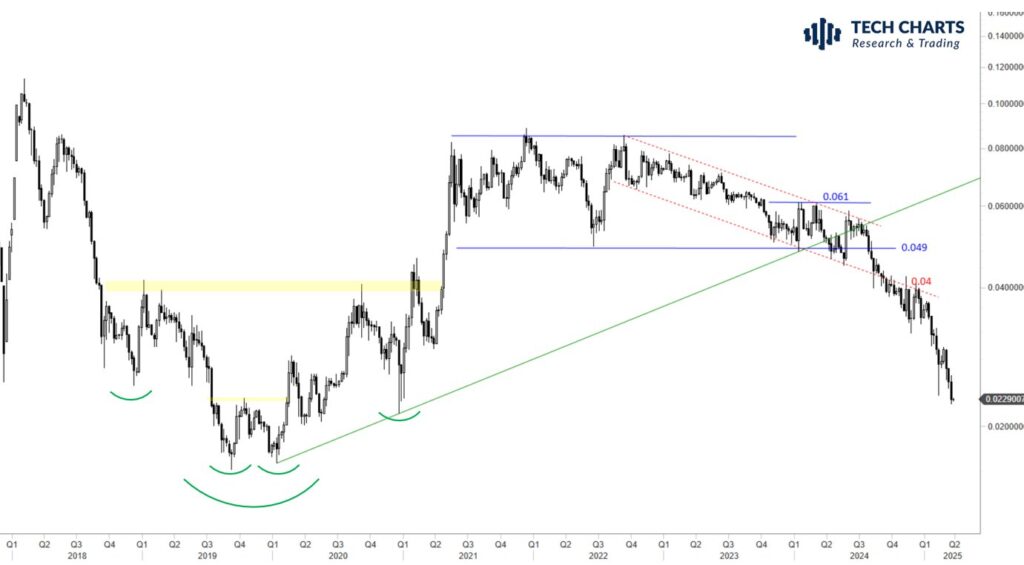In the ever-evolving landscape of cryptocurrency, Ethereum (ETH) is currently in a challenging position. Recent data from TradingView indicates that Ethereum’s price has plummeted more than 52% from its December 2024 high of ,107 and is down 42% since the start of 2025. Despite being a heavyweight in the cryptocurrency arena, known for its pivotal roles in Web3 and decentralized finance (DeFi), analysts are projecting a rather bleak outlook for ETH in the near term.
Notably, crypto analyst Aksel Kibar has cautioned traders about the misconception that ETH’s current price represents a discount simply due to its position relative to historical averages. Kibar emphasized on social media that “bottom reversals take time,” suggesting that the necessary supply accumulation could prolong the downturn. He draws parallels to past market behavior, noting that for ETH to outperform Bitcoin (BTC), it would need to replicate the positive price action observed between 2018 and 2020, a period marked by significant recovery after a prolonged decline.
“Those of you that want to see ETH outperform BTC need to see similar price action to 2018-2020 period,” Kibar explained. “Currently, ETH’s chart does not show any type of bottoming formation.”
Adding to the sobering sentiment, Standard Chartered recently slashed its end-of-2025 price prediction for Ethereum from ,000 to just ,000, marking a staggering 60% decrease. Geoff Kendrick, the bank’s global head of Digital Assets Research, has indicated that Ethereum’s ongoing structural decline is linked to various factors, including the impact of layer 2 blockchains like Base. These developments have reportedly siphoned away around billion from Ethereum’s market cap, according to Kendrick. He noted that these layer 2 solutions, which were initially designed to enhance Ethereum’s scalability, are inadvertently diminishing its fee revenue.
“Layer 2 blockchains were meant to improve ETH scalability, but we estimate that Base has removed USD 50bn from ETH’s market cap,” Kendrick stated.
Furthermore, analysts from VanEck have echoed these concerns, highlighting a broader trend where Ethereum’s fundamental value appears to be eroding. These researchers pinpoint layer 2 blockchains, including Arbitrum and Base, as significant contributors to the decrease in ETH’s fee revenue, compounded by rising interest in meme trading on the Solana blockchain.
As Ethereum faces these multifaceted challenges, it raises critical questions about its future positioning in the cryptocurrency market and the implications of these shifts for investors and users alike.
Ethereum Price Outlook: Key Insights
The following key points summarize the current challenges and outlook for Ethereum (ETH) and how they may impact investors and crypto enthusiasts:
- Significant Price Decline:
- Ethereum’s price is more than 52% down from its December 2024 high of ,107.
- Data from TradingView shows ETH has dropped 42% since the start of 2025.
- Analysts’ Pessimism:
- Many analysts suggest that the short-term price prospects for ETH remain grim.
- Analyst Askel Kibar cautions against the assumption that ETH is trading at a discount based on its historical prices.
- No Bottoming Formation:
- Kibar compares trading Ethereum to “catching a falling knife,” indicating a lack of a stable bottom.
- The current chart shows no bottoming formation similar to the 2018-2020 period when ETH found stability.
- Revised Price Estimates:
- Standard Chartered has lowered its end-of-2025 ETH price estimate from ,000 to ,000.
- Geoff Kendrick from Standard Chartered expects a continuous structural decline for ETH.
- Impact of Layer 2 Blockchains:
- Layer 2 solutions like Base are affecting ETH’s scalability and overall market cap, possibly reducing ETH’s fee revenue.
- Base’s success has led to an estimated billion taken from ETH’s market cap.
- Long-Term Accumulation Risks:
- Analysts warn that long-term accumulation of ETH may be jeopardized if the price falls below ,900.
- Competition from other blockchains, like Solana, may further diminish ETH’s value proposition.
This information emphasizes the risks associated with investing in Ethereum and highlights the importance of conducting thorough research before making any financial commitments in the cryptocurrency market.
Ethereum’s Price Downfall: A Comparative Look at Current Challenges
The recent downturn in Ethereum’s price has caught the attention of crypto enthusiasts and analysts alike. Currently, the digital asset has witnessed a staggering drop of over 52% from its December 2024 peak of ,107. In the landscape of cryptocurrencies, ETH finds itself amidst a tough competition from other blockchain projects, particularly Layer 2 solutions and rival cryptocurrencies like Solana. This presents both opportunities and challenges for various stakeholders in the crypto ecosystem.
Competitive Advantages: Ethereum’s primary strengths lie in its dominant position within the Web3 and DeFi arenas. As one of the largest cryptocurrencies by market capitalization, it continues to garner interest from institutional investors. Additionally, its innovations in smart contracts and decentralized applications (dApps) remain a draw despite its price struggles. This foundational strength might encourage long-term holders and developers to remain invested, potentially stabilizing ETH in the face of market volatility.
Competitive Disadvantages: However, the most recent analyses highlight significant headwinds. Analysts from Standard Chartered and VanEck have issued grim forecasts, citing that Ethereum’s core value propositions have deteriorated. The introduction of Layer 2 solutions, such as Base and Arbitrum, has siphoned off revenue that once bolstered Ethereum’s ecosystem. As pointed out, this shift could dilute investor confidence, especially with alternatives like Solana that are appealing due to their lower fees and faster transaction times.
These factors collectively spell trouble for short-term traders and speculators, who may feel as though they are “catching a falling knife” in a volatile market. Investors who are heavily reliant on the fee revenue generated by Ethereum’s network might find themselves grappling with shrinking profits as Layer 2 solutions capture a disproportionate share of the market.
Moreover, the impending price revisions and the cautionary advice from notable analysts could create a ripple effect, deterring new investments and further suppressing Ethereum’s price. This creates a perilous situation for those looking to enter the market, as conservative strategies might lead them to choose more stable investments instead.
In contrast, established players in the crypto space, already invested in Ethereum, might find this period an opportune time to accumulate more for long-term growth, despite the prevailing market skepticism. The intricate dance of Ethereum’s price, influenced by both internal dynamics and external competition, suggests a mixed bag of potential for various market participants.

















